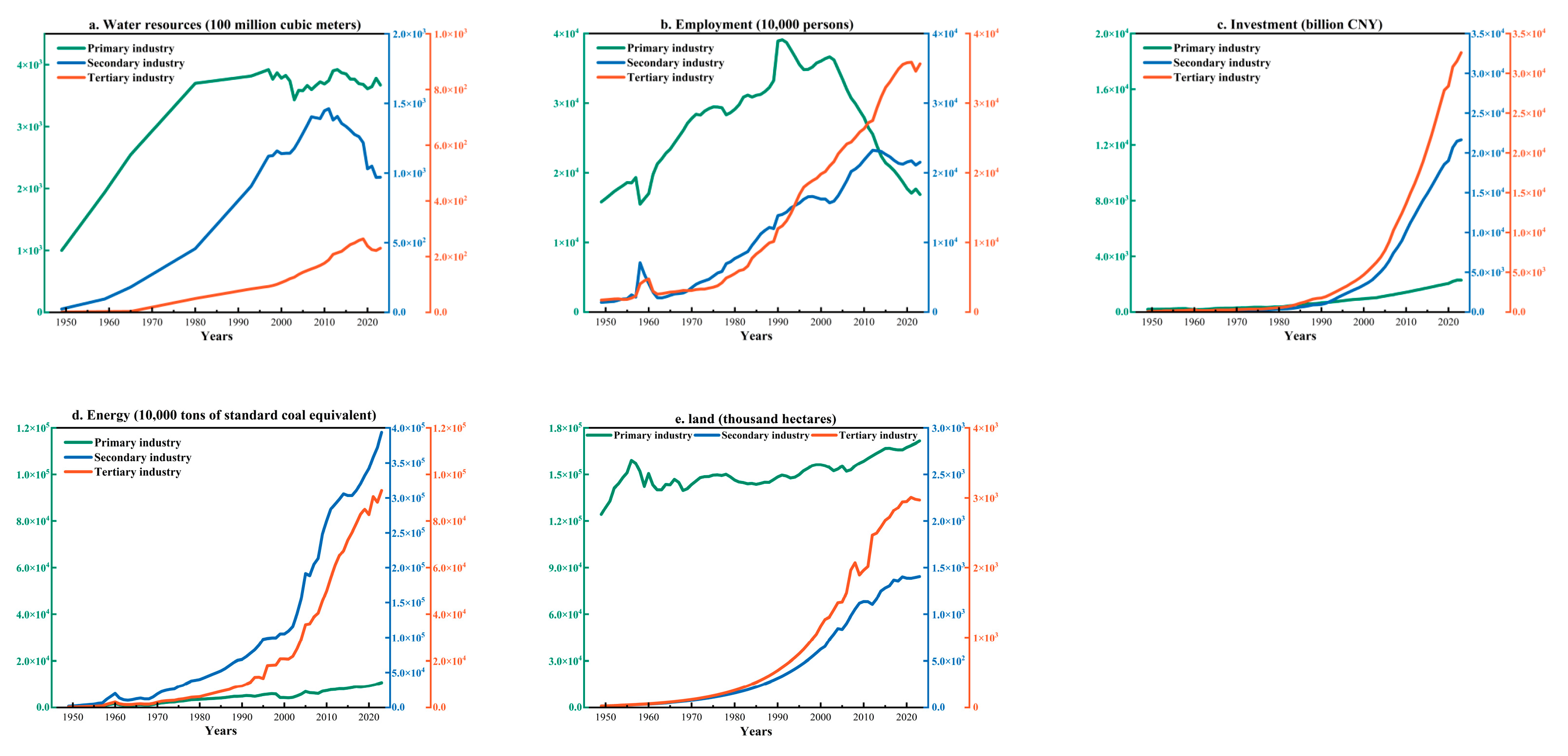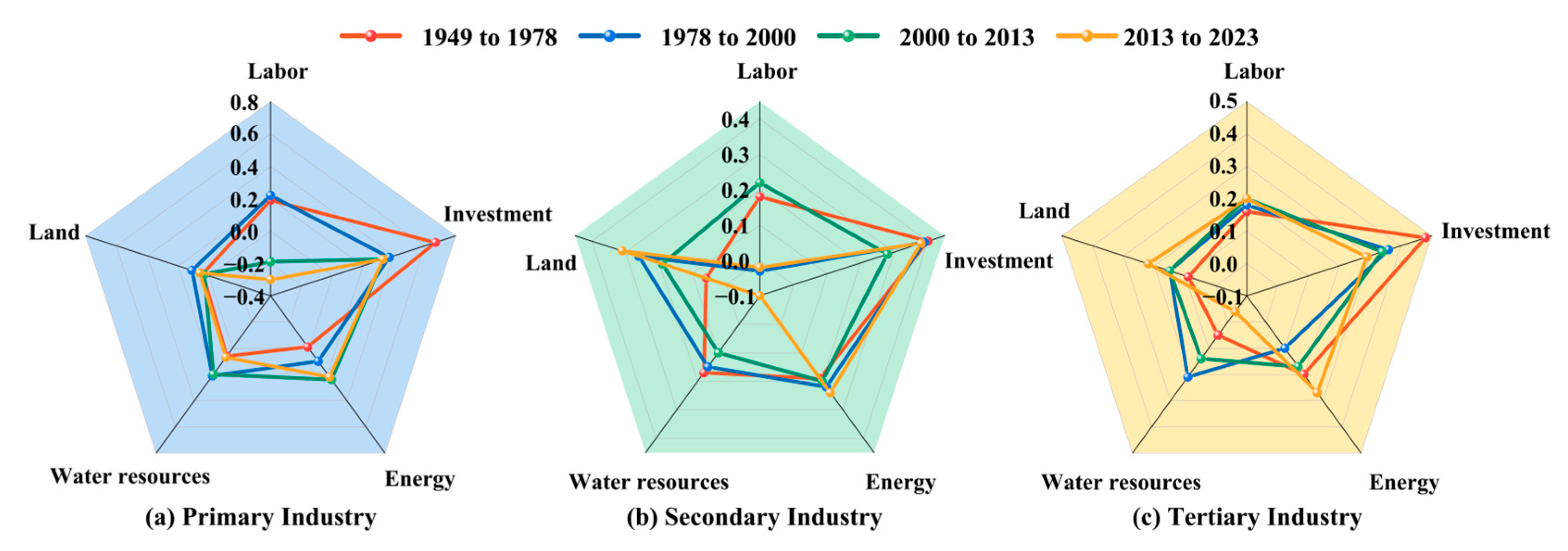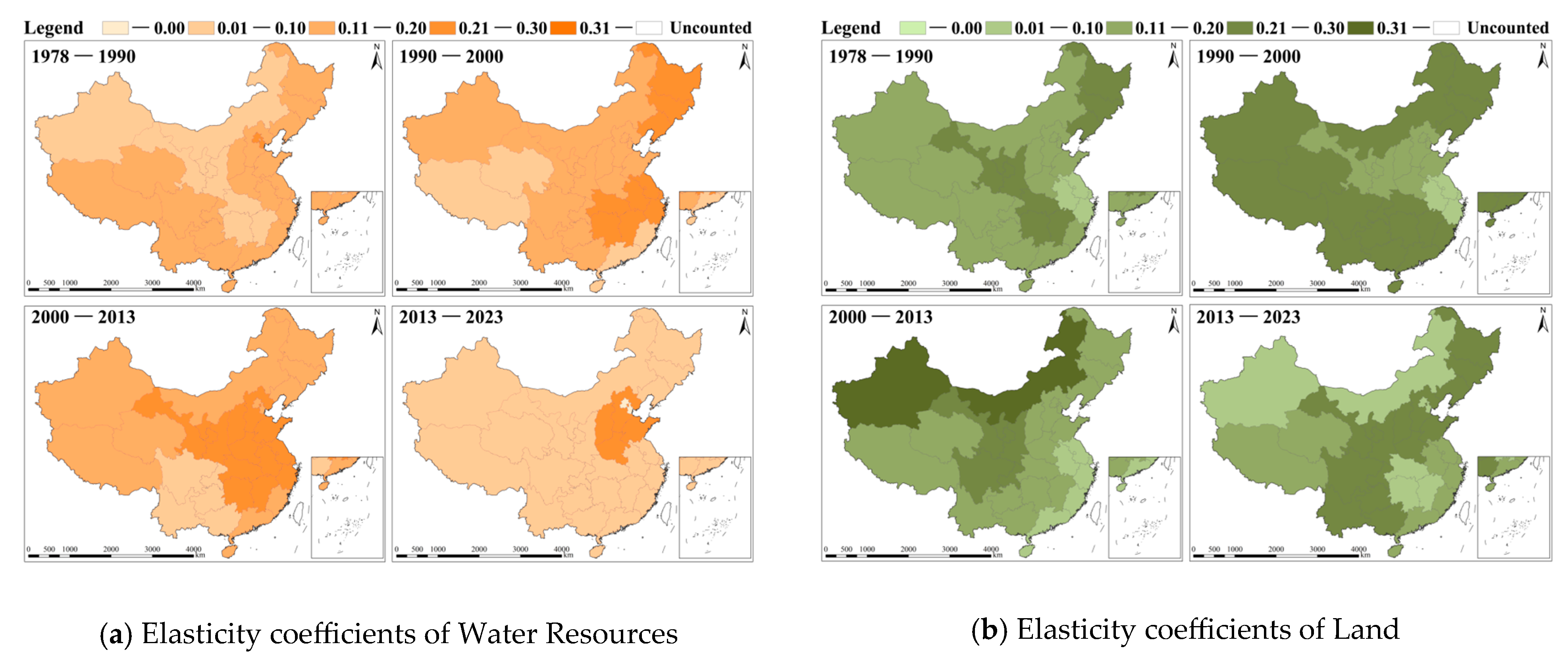Analyzing the Multifactor Driving Mechanism and Patterns of Economic Development in China from a Water Resource Perspective
Abstract
1. Introduction
2. Materials and Methods
2.1. Multifactor Production Model
2.2. Regional Division
2.3. Data Sources
3. Results
3.1. Temporal Dynamics of Fundamental Variables
3.2. Estimation Results of the Multifactor Production Model
3.3. Evolution of Factor Contributions at the National Level
3.3.1. Evolution of Factor Contributions
- Evolution of Factor Contributions in the Primary Industry
- 2.
- Evolution of Factor Contributions in the Secondary Industry
- 3.
- Evolution of Factor Contributions in the Tertiary Industry
3.3.2. Analysis of the Underlying Causes of Factor Contributions
3.4. Regional Differences in the Contribution of Factors to Economic Growth
3.4.1. Changes in the Contribution of Water and Land Resources to the Primary Industry
- 1.
- Trends in the Contribution of Water Resources.
- 2.
- Trends in the Contribution of Arable Land
- 3.
- Assessment of Key Agricultural Development Zones Based on Water-Land Resource Matching
3.4.2. Changes in the Contribution of Water and Land Resources to the Secondary Industry
- 1.
- Trends in the Contribution of Water Resources
- 2.
- Trends in the Contribution of Land
3.4.3. Changes in the Contribution of Water and Land Resources to the Tertiary Industry
- 1.
- Trends in the Contribution of Water Resources
- 2.
- Trends in the Contribution of Land
4. Discussion
4.1. Drivers Behind the Shifting Role of Water Resources in Socioeconomic Development
4.2. Types of Water Resource Constraints
4.3. Policy Recommendations for Regional Development Based on Water-Land Resource Coordination
4.4. Limitations and Future Directions
5. Conclusions
Author Contributions
Funding
Institutional Review Board Statement
Informed Consent Statement
Data Availability Statement
Conflicts of Interest
Appendix A
| Industry | Study Period | Elasticity Coefficient and Significance of X | Goodness of Fit (R2) | Significance Test (F-Test) | Ridge Parameter (k) | ||||
|---|---|---|---|---|---|---|---|---|---|
| Labor | Investment | Energy | Water Resources | Land | |||||
| Primary industry | From 1949 to 1978 | 0.19 *** | 0.671 *** | −0.011 | 0.055 ** | 0.041 | 0.97 | 154.032 *** | 0.168 |
| From 1978 to 2000 | 0.223 *** | 0.366 *** | 0.101 ** | 0.206 *** | 0.105 *** | 0.978 | 150.682 *** | 0.186 | |
| From 2000 to 2013 | −0.186 *** | 0.33 *** | 0.236 *** | 0.201 *** | 0.033 | 0.985 | 105.515 *** | 0.167 | |
| From 2013 to 2023 | −0.303 *** | 0.33 *** | 0.219 *** | 0.073 | 0.063 | 0.987 | 75.9 *** | 0.18 | |
| Secondary industry | From 1949 to 1978 | 0.179 *** | 0.396 *** | 0.191 *** | 0.174 *** | 0.055 * | 0.992 | 568.32 *** | 0.061 |
| From 1978 to 2000 | −0.031 | 0.392 *** | 0.217 *** | 0.148 *** | 0.263 *** | 0.996 | 950.382 *** | 0.036 | |
| From 2000 to 2013 | 0.223 *** | 0.284 *** | 0.197 *** | 0.102 ** | 0.193 *** | 0.996 | 375.374 *** | 0.063 | |
| From 2013 to 2023 | −0.02 | 0.375 *** | 0.244 *** | −0.096 * | 0.312 *** | 0.99 | 101.36 *** | 0.144 | |
| Tertiary industry | From 1949 to 1978 | 0.156 *** | 0.477 *** | 0.202 *** | 0.05 | 0.09 *** | 0.981 | 253.667 *** | 0.107 |
| From 1978 to 2000 | 0.178 *** | 0.361 *** | 0.104 ** | 0.208 *** | 0.147 *** | 0.998 | 1526.121 *** | 0.018 | |
| From 2000 to 2013 | 0.197 *** | 0.339 *** | 0.171 *** | 0.138 *** | 0.149 ** | 0.995 | 347.974 *** | 0.04 | |
| From 2013 to 2023 | 0.199 *** | 0.293 *** | 0.267 *** | −0.036 | 0.215 *** | 0.99 | 103.723 *** | 0.197 | |
References
- Vorosmarty, C.J.; McIntyre, P.B.; Gessner, M.O.; Dudgeon, D.; Prusevich, A.; Green, P.; Glidden, S.; Bunn, S.E.; Sullivan, C.A.; Liermann, C.R.; et al. Global threats to human water security and river biodiversity. Nature 2010, 467, 555–561. [Google Scholar] [CrossRef] [PubMed]
- Imran, K. Water Sharing Issues in Pakistan: Impacts on Inter-Provincial Relations. J. Dev. Soc. Sci. 2021, 2, 74. [Google Scholar] [CrossRef]
- Zhang, Y.; Jin, Z.; Shan, B.; Wang, Y.; Ma, J. Review of research on international water resources conflict and resolution. World Reg. Stud. 2024, 33, 27–39. [Google Scholar] [CrossRef]
- Karaki, F.J. The Impact of Manufacturing, Investment, Labor Force and Technology on Economic Growth in Palestine. J. Econ. Financ. Account. Stud. 2023, 5, 164–173. [Google Scholar] [CrossRef]
- Arcos-Guanga, A.; Flor-Unda, O.; Novillo-Villegas, S.; Acosta-Vargas, P. The Impact of Knowledge Spillovers on Economic Growth from a National Perspective: A Comprehensive Analysis. Sustainability 2024, 16, 6537. [Google Scholar] [CrossRef]
- Daud, S.N.M.; Ahmad, A.H. Financial inclusion, economic growth and the role of digital technology. Financ. Res. Lett. 2023, 53, 103602. [Google Scholar] [CrossRef]
- Teng, Y.P. Green Energy and Land Resources: COP27 Perspective of BRICS Economic Growth and Land Production. Land Degrad. Dev. 2024, 35, 5267–5280. [Google Scholar] [CrossRef]
- Usman, M.; Jahanger, A.; Makhdum, M.S.A.; Balsalobre-Lorente, D.; Bashir, A. How do financial development, energy consumption, natural resources, and globalization affect Arctic countries’ economic growth and environmental quality? An advanced panel data simulation. Energy 2022, 241, 122515. [Google Scholar] [CrossRef]
- Zhang, C.; Waris, U.; Qian, L.; Irfan, M.; Rehman, M.A. Unleashing the dynamic linkages among natural resources, economic complexity, and sustainable economic growth: Evidence from G-20 countries. Sustain. Dev. 2024, 32, 3736–3752. [Google Scholar] [CrossRef]
- Balistreri, E.J.; McDaniel, C.A.; Wong, E.V. An estimation of US industry-level capital–labor substitution elasticities: Support for Cobb–Douglas. N. Am. J. Econ. Financ. 2003, 14, 343–356. [Google Scholar] [CrossRef]
- Muro, K. A note on the three-sector Cobb–Douglas GDP function. Econ. Model. 2013, 31, 18–21. [Google Scholar] [CrossRef]
- Skare, M.; Ozturk, I.; Porada-Rochoń, M.; Stjepanovic, S. Energy as the new frontier: Dynamic panel data analysis revealing energy’s transformative role in economic growth and technological progress. Technol. Forecast. Soc. Change 2024, 200, 123175. [Google Scholar] [CrossRef]
- Keen, S.; Ayres, R.U.; Standish, R. A Note on the Role of Energy in Production. Ecol. Econ. 2019, 157, 40–46. [Google Scholar] [CrossRef]
- Santos, J.; Domingos, T.; Sousa, T.; Aubyn, M.S. Useful Exergy Is Key in Obtaining Plausible Aggregate Production Functions and Recognizing the Role of Energy in Economic Growth: Portugal 1960–2009. Ecol. Econ. 2018, 148, 103–120. [Google Scholar] [CrossRef]
- Liu, Y.; Zhang, Z.; Zhou, Y. Efficiency of construction land allocation in China: An econometric analysis of panel data. Land Use Policy 2018, 74, 261–272. [Google Scholar] [CrossRef]
- Su, K.; He, D.; Wang, R.; Han, Z.; Deng, X. Assessment of natural resource endowment and urban-rural integration for sustainable development in Xinjiang, China. J. Clean. Prod. 2024, 450, 142046. [Google Scholar] [CrossRef]
- Lu, Z.; Li, Y.; Li, W. To uncover economic losses and mitigation benefits of agricultural water scarcity by considering water availability, quality, and efficiency in China’s largest dryland River Basin. Environ. Impact Assess. Rev. 2025, 114, 107924. [Google Scholar] [CrossRef]
- Wang, C.; Shuai, C.; Chen, X.; Huang, W.; Hou, W.; Zhao, B.; Sun, J. Analyzing the potential local and distant economic loss of global construction sector due to water scarcity. Environ. Impact Assess. Rev. 2025, 110, 107667. [Google Scholar] [CrossRef]
- Montoya, M.A.; Allegretti, G.; Bertussi, L.A.S.; Talamini, E. Domestic and foreign decoupling of economic growth and water consumption and its driving factors in the Brazilian economy. Ecol. Econ. 2023, 206, 107737. [Google Scholar] [CrossRef]
- Wang, Q.; Wang, X.; Li, R. The impact of globalization on the decoupling of water consumption and economic growth in BRICS and N11 countries—Linear and nonlinear approaches. Sustain. Dev. 2023, 32, 755–776. [Google Scholar] [CrossRef]
- Jian, S.; Cheng, X.; Wang, T.; Dou, S. The driving factors of water use and its decoupling relationship with economic development—A multi-sectoral perspective in the nine provinces of the Yellow River Basin. J. Hydrol. Reg. Stud. 2025, 59, 102338. [Google Scholar] [CrossRef]
- Wang, Q.; Wang, X. Moving to economic growth without water demand growth—A decomposition analysis of decoupling from economic growth and water use in 31 provinces of China. Sci. Total Environ. 2020, 726, 138362. [Google Scholar] [CrossRef]
- Tao, M.; Zhao, Y.; Jiang, Q.; Wang, Z.; Li, B. Study on the coupled coordination of water resources consumption and economic development in Heilongjiang province under different scenarios based on SD model. Agric. Water Manag. 2025, 315, 109560. [Google Scholar] [CrossRef]
- Wu, Q.; Zuo, Q.; Ma, J.; Zhang, Z.; Jiang, L. Evolution analysis of water consumption and economic growth based on Decomposition-Decoupling Two-stage Method: A case study of Xinjiang Uygur Autonomous Region, China. Sustain. Cities Soc. 2021, 75, 103337. [Google Scholar] [CrossRef]
- Gong, Q.; Guo, G.; Li, S.; Liang, X. Decoupling of urban economic growth and water consumption in Chongqing and Chengdu from the “production-living-ecological” perspective. Sustain. Cities Soc. 2021, 75, 103395. [Google Scholar] [CrossRef]
- Rusiadi, R.; Hidayat, M.; Rangkuty, D.M.; Ferine, K.F.; Saputra, J. The Influence of Natural Resources, Energy Consumption, and Renewable Energy on Economic Growth in ASEAN Region Countries. Int. J. Energy Econ. Policy 2024, 14, 332–338. [Google Scholar] [CrossRef]
- Ali, A.; Li, J.; Zhang, J.; Chishti, M.Z. Exploring the impact of green finance and technological innovation on green economic growth: Evidence from emerging market economies. Sustain. Dev. 2024, 32, 6392–6407. [Google Scholar] [CrossRef]
- Sun, D.; Shi, M.; Wei, J.; Chen, Z. Economic contribution and rebound effect of industrial water: The case of the Yangtze River Delta. Water Resour. Econ. 2023, 42, 100222. [Google Scholar] [CrossRef]
- Zhang, F.; Wang, H.; Qin, T.; Rojas, R.; Qiu, L.; Yang, S.; Fang, Z.; Xue, S. Towards sustainable management of agricultural resources: A framework to assess the relationship between water, soil, economic factors, and grain production. J. Environ. Manag. 2023, 344, 118401. [Google Scholar] [CrossRef] [PubMed]
- Zhang, L.; Ma, Q.; Zhao, Y.; Chen, H.; Hu, Y.; Ma, H. China’s strictest water policy: Reversing water use trends and alleviating water stress. J. Environ. Manag. 2023, 345, 118867. [Google Scholar] [CrossRef]
- Su, X.; Zhou, W.; Nakagami, K.I.; Ren, H.; Mu, H. Capital stock-labor-energy substitution and production efficiency study for China. Energy Econ. 2012, 34, 1208–1213. [Google Scholar] [CrossRef]
- Mann, K.; Püttmann, L. Benign Effects of Automation: New Evidence from Patent Texts. Rev. Econ. Stat. 2023, 105, 562–579. [Google Scholar] [CrossRef]
- Qiao, X.; He, Y.; Du, Q. How does the urban digital economy drive labor allocation in China?—A perspective of factor mobility between digital and non-digital enterprises. Econ. Anal. Policy 2025, 85, 1159–1175. [Google Scholar] [CrossRef]
- Zhang, Z. The impact of the artificial intelligence industry on the number and structure of employments in the digital economy environment. Technol. Forecast. Soc. Change 2023, 197, 122881. [Google Scholar] [CrossRef]
- Chansarn, S. Labor Productivity Growth, Education, Health and Technological Progress: A Cross-Country Analysis. Econ. Anal. Policy 2010, 40, 249–261. [Google Scholar] [CrossRef]
- Liu, C.; Song, C.; Ye, S.; Cheng, F.; Zhang, L.; Li, C. Estimate provincial-level effectiveness of the arable land requisition-compensation balance policy in mainland China in the last 20 years. Land Use Policy 2023, 131, 106733. [Google Scholar] [CrossRef]
- Zheng, X.; Ma, C.; Lv, H.; Wan, F.; Wang, H. Evolution and drivers of water use in Northern China. J. Hydrol. Reg. Stud. 2025, 59, 102419. [Google Scholar] [CrossRef]
- Wang, X.; Zhang, W.; Li, Y.; Tong, J.; Yu, F.; Ye, Q. Impacts of water constraints on economic outputs and trade: A multi-regional input-output analysis in China. J. Clean. Prod. 2024, 434, 140345. [Google Scholar] [CrossRef]
- Huang, G.; Liu, C.; Xi, T.; Xu, H.; You, W. The agricultural and economic impacts of massive water diversion. J. Dev. Econ. 2025, 176, 103517. [Google Scholar] [CrossRef]
- Wang, Z.; Xie, J. Water constraint mitigation and agricultural productivity: Evidence from the China’s South-to-North Water Diversion Project. Agric. Water Manag. 2025, 314, 109511. [Google Scholar] [CrossRef]
- Diao, Y.; Xia, J.; Dong, Q.; Zuo, Q.; Xie, M. From resource matching to economic sustainability: A multi-stage analysis of water-land-economy interactions in the lower Yellow River Basin. J. Environ. Manag. 2025, 380, 125078. [Google Scholar] [CrossRef] [PubMed]
- Meng, X.; Liu, L. Spatial-temporal evolution and influencing factors of food production security in China’s main food-producing areas − based on resource constraint perspective. Ecol. Indic. 2025, 171, 113224. [Google Scholar] [CrossRef]
- Ban, Y.; Tang, Q.; Liu, X.; Li, X.; Ren, Y.; Deng, H.; Zhao, G.; Zhang, Y.; Zhang, Y.; Leng, G. Intensification of water scarcity threatens future food security in northwestern China. J. Hydrol. Reg. Stud. 2025, 58, 102177. [Google Scholar] [CrossRef]
- Wang, Y.; Zhou, Y.; Zhang, X.; Franz, K.J.; Jia, G. Water regulation mitigates but does not eliminate water scarcity under rapid economic growth in the Haihe River basin. Resour. Conserv. Recycl. 2025, 215, 108098. [Google Scholar] [CrossRef]






| Development Type | Main Research Zones | Driving/Constraining Factors |
|---|---|---|
| Suitable Development Zone | Research zone 6, Research zone 9 | Favorable light and thermal conditions; good water–land resource matching; limited reserve arable land; and relatively weak development potential |
| Potential Development Zone | Research zone 1, Research zone 10, Research zone 4 | Major reserve arable land areas in China; limited water resources, which constrain agricultural development |
| Unsuitable Development Zone | Research zone 11, Research zone 5, Research zone 7, Research zone 8, Research zone 2, Research zone 3 | Ecological conservation; insufficient reserve arable land; constraints from limited water resource carrying capacity |
Disclaimer/Publisher’s Note: The statements, opinions and data contained in all publications are solely those of the individual author(s) and contributor(s) and not of MDPI and/or the editor(s). MDPI and/or the editor(s) disclaim responsibility for any injury to people or property resulting from any ideas, methods, instructions or products referred to in the content. |
© 2025 by the authors. Licensee MDPI, Basel, Switzerland. This article is an open access article distributed under the terms and conditions of the Creative Commons Attribution (CC BY) license (https://creativecommons.org/licenses/by/4.0/).
Share and Cite
Che, W.; Qin, C.; Zhao, Y.; He, F.; Qu, J.; Guan, Z. Analyzing the Multifactor Driving Mechanism and Patterns of Economic Development in China from a Water Resource Perspective. Sustainability 2025, 17, 9174. https://doi.org/10.3390/su17209174
Che W, Qin C, Zhao Y, He F, Qu J, Guan Z. Analyzing the Multifactor Driving Mechanism and Patterns of Economic Development in China from a Water Resource Perspective. Sustainability. 2025; 17(20):9174. https://doi.org/10.3390/su17209174
Chicago/Turabian StyleChe, Wenxin, Changhai Qin, Yong Zhao, Fan He, Junlin Qu, and Ziyu Guan. 2025. "Analyzing the Multifactor Driving Mechanism and Patterns of Economic Development in China from a Water Resource Perspective" Sustainability 17, no. 20: 9174. https://doi.org/10.3390/su17209174
APA StyleChe, W., Qin, C., Zhao, Y., He, F., Qu, J., & Guan, Z. (2025). Analyzing the Multifactor Driving Mechanism and Patterns of Economic Development in China from a Water Resource Perspective. Sustainability, 17(20), 9174. https://doi.org/10.3390/su17209174





